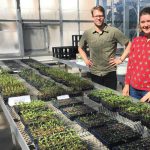BioCycle January 2019
Environmental Commissioner Weighs In On Water Quality
BioCycle Contributing Editor Peter Gorrie interviews Ontario Environmental Commissioner Dianne Saxe
Less than a month after Ontario’s environmental watchdog criticized the Canadian province’s “appalling” record of protecting drinking water sources and surface waters from pollution, the government introduced legislation that would further weaken safeguards. The criticism came in the annual report from Environmental Commissioner Dianne Saxe, who noted that during the past reporting year, raw sewage overflowed into southern Ontario waters 1,327 times. More than half the spills came during heavy rains, from outdated municipal sewer systems that combine sewage with storm water, stated Saxe, who has held the post since 2015, and whose office has been downgraded in another move by the new government: “It is unbelievable that in 2018, the government allows this much filth into our lakes and rivers.”
While her report does not explicitly refer to compost and digestate, in our interview Saxe supported their use as soil amendments because they reduce runoff, and cut demand for chemical fertilizers, and the application of raw manure on farmland. “Definitely, adding organic material into soil is a great idea,” she told BioCycle.
Climate change is causing increasingly heavy and intense rain events, making overflows more likely, the Commissioner’s report noted. It recommended replacement of combined storm and sanitary sewers as well as measures to reduce pollution from urban and agricultural runoff and industrial outflows. Protection of drinking water sources, mainly from agricultural runoff, has been a major concern in Ontario since 2000, when the water treatment system in the rural town of Walkerton failed to eliminate E. coli bacteria from cattle manure spread on nearby farms. The contamination killed seven people and made dozens ill.
In 2006, the province passed a Clean Water Act to control development and agricultural activities near water sources. The law established local committees to devise protection plans. They “have identified hundreds of significant pollution threats … and have done what they can to manage them,” Saxe’s report stated. But they “have not been given the tools needed to properly regulate some important threats,” including manure spreading.
As for surface waters, Saxe’s report noted that a recently announced government strategy for agricultural runoff “recognizes that increasing soil organic carbon and lowering the risk of erosion are desired outcomes.”
However, since it lacks concrete targets and incentives, “the strategy does not commit Ontario to do much to actually achieve better soil health,” continues the report. “…
The government has responded to agricultural runoff with weak laws, poor monitoring, minimal enforcement, and too little financial support for improving soil health. It should, therefore, be little surprise that agricultural nutrient runoff is feeding algae growth in so many of Ontario’s lakes and rivers.”
Similarly, little is being done to prevent the loss of water-holding wetlands and forest cover to urban development, agriculture, and the extraction of peat for gardening and horticultural use. Ontario banned new combined storm and sanitary sewers 30 years ago, but hasn’t forced municipalities to upgrade old systems. The report recommended the province require every municipality with combined sewers to “do everything practicable to virtually eliminate overflows within a reasonable time.” It also called for measures to ensure “dramatic” reductions in phosphorus runoff from farms, “with clear targets, effective monitoring, and financial incentives.”
The changes proposed by the Conservative government, which defeated the Liberal administration in an election in June 2018, would weaken the Clean Water Act by allowing environmentally damaging developments if they promise a minimum number of jobs. The proposed law would “give developers a pass on keeping drinking water safe,” and allow for any protections of water bodies (in the Clean Water Act) to be ignored,” said Tim Gray, executive director of the lobby group Environmental Defence.
Shortly after Saxe released her report the government announced that her office would be downgraded by incorporation into the Office of the Auditor General. Details of the move, also condemned by environment groups, are not yet available. “My hope is to maintain our independence as far as we can, but we don’t know,” Saxe said in the interview. She did offer one piece of good news: The government will likely continue the previous administration’s plan to dramatically reduce the amount of organic materials going into landfills, and to promote development of renewable natural gas.
2018 Farm Bill And Organics Recycling
The Harvard Food Law & Policy Clinic (HFLPC), in partnership with Farm Bill Law Enterprise, found good news for food waste reduction measures in the 2018 Farm Bill Conference Report, which was approved by both the Senate and the House, and was signed by the President on December 20. Among the highlights, notes an HFLPC summary, are:
• Major investment in a program proposed in the Senate farm bill to provide funding for development of local composting and food waste reduction. This program allocates $25 million/year for pilot projects in at least 10 states to develop and implement municipal compost plans and food waste reduction plans. Eligible projects must increase access to compost for agricultural producers.
• Creates a Food Loss and Waste Reduction Liaison as a new staff position in the USDA to “coordinate Federal programs to measure and reduce the incidence of food loss and waste.”
• Provision clarifying liability protections for food donation and allowing for food donation directly from certain donors to individuals.
Also in the Farm Bill report is a provision to support education around biogas. It directs USDA, in coordination with EPA and the Department of Energy, to establish an Interagency Biogas Opportunities Task Force to coordinate policies and programs to accelerate biogas research and investments into biogas systems. It also contains an authorization for $1 million for each fiscal year 2019-2023 to provide education to agricultural producers and other stakeholders about opportunities for aggregation of organic waste from multiple sources into a single biogas system.
Waste Not Wednesdays
The James Beard Foundation announced the launch of Waste Not, a multiyear campaign designed to encourage culinary professionals and home cooks to reduce food waste by thinking differently about food and adopting full-use cooking methods. The campaign is urging Americans to start with small changes just one day a week — on Waste Not Wednesday. “If all Americans eliminated food waste on Waste Not Wednesdays, more than 7.8 million tons of food would be saved each year — enough to provide almost 13 billion meals to the hungry,” stated a Foundation press release.
The James Beard Foundation in collaboration with long-standing partners, has created a series of educational tools and events to support the Waste Not campaign, including:
• Waste Not: A new cookbook featuring more than 100 unique recipes by 65 well-known chefs who incorporate commonly discarded ingredients to build layers of flavor. Tips and tricks for turning root tops, bones, scraps, seeds, and other ingredients into essential building blocks of good food are providing.
• Creating a Full-Use Kitchen: This curriculum is designed to train the next generation of chefs and culinary professionals on techniques and creative approaches to food waste that reduce costs, improve nutrition and enhance sustainability.
• Culinary Labs: An experiential learning opportunity is being created for culinary professionals from across the country to increase their understanding of food-systems issues — including food waste reduction — sustainable solutions, and practical application.
• Taste America: A 10-city tour celebrates the country’s diverse culinary culture and the important role that chefs play in advocating for a more delicious, sustainable, and equitable food world. The first tour features unique dining events and in-store cooking demonstrations at Sur La Table. Viable leftover food from the events will be donated to those in need in partnership with Feeding America.
• Chefs Boot Camp for Policy and Change: The program trains chefs to become advocates for eliminating food waste and adopting more sustainable practices. More than 200 chefs have already been trained and another 50 are expected to participate next year.
• Waste Reduction Practices: Steps to reduce food waste by an estimated 30 percent will be implemented at dining events hosted at the historic James Beard House and around the country.
“Even a 15 percent reduction in food waste could save enough food to feed 25 million Americans annually,” noted chef Tom Colicchio in the forward to the Waste Not cookbook. “Small habits, adopted by many, can tip a culture from indifference and neglect toward a saner, more just future in which we all can share.”
Food Waste Pretreatment Systems Directory
The Composting Collaborative released its online Pretreatment Directory, along with guidance about on-site food waste preprocessing systems that liquefy or size-reduce food waste, often using enzymes or microbes and heat. The Directory is a listing of 21 companies and 85 units currently available in the market. There are two general categories of pretreatment systems — wet and dry — note the authors, James Ewell and Charlotte Dreizen with GreenBlue.
Aerobic digesters, also referred to as liquefiers or biodigesters, are wet systems using fresh water to dilute solids in combination with microorganisms to “digest” food waste into a liquid effluent that can be sent “down the drain” via sewer to a wastewater resource recovery facility (WRRF), or pumped to a holding tank for transport to third-party locations like an anaerobic digestion facility, a commercial composting site or a WRRF that accepts “outside” food waste (not conveyed via sewer). Dehydrators and accelerated composters are dry systems. They dehydrate food waste through high temperature heating or through slow turning and agitation over a longer period of time. Outputs from dry systems can be cured into mature compost on-site or transported to a dedicated compost manufacturing facility. Dry output is sometimes also used for livestock bedding on farms or as an input for animal or fish feed.
A recent study of the market for on-site food waste recycling systems by Fact.MR projects that 10,890 units will be sold in 2019, a slight increase from 2018. Sales of this equipment have remained concentrated in the restaurant industry. The top 5 vendors in the industry account for nearly 20 percent revenue share.
Fertilizers’ Impact On Soil Health Compared
In a study published in the Soil Science Society of America journal in September 2018, researchers investigated how fertilizing with manure affected soil quality, compared with inorganic fertilizer. The University of Wisconsin-Madison team evaluated two fields in South Dakota. Either manure or inorganic fertilizer were applied to field plots under corn (Zea mays L.)/soybean (Glycine max L.) rotation from 2003 to 2015. Low, medium, and high manure levels, and medium and high inorganic fertilizer levels were utilized. The researchers also had a control treatment of no soil additives to provide a comparison.
Soil samples were collected at a variety of depths in the summer of 2015. Analysis yielded the following results:
• Manure helped keep soil pH in a healthy range for crops. Inorganic fertilizer made the soil more acidic.
• Manure increased soil organic carbon for all the measured soil depths compared to inorganic fertilizer and control treatments. More organic carbon means better soil structure.
• Manure significantly increased total nitrogen in the soil compared to fertilizer treatments.
• Manure increased water-stable aggregates, which are groups of soil particles that stick to each other. Increased water-stable aggregates help soil resist erosion. Inorganic fertilizer application decreased these aggregates.
• Manure increased soil electrical conductivity at all soil depths (1.56 dS/m) in comparison to inorganic fertilizer (0.71 dS/m) and control treatments. Higher soil electrical conductivity means higher salt levels in the soil.
Data from this study concluded that the long-term annual application of manure improved selected soil properties compared to that of inorganic fertilizer.
Circular Economy And Improved Recycling
To improve municipal waste management practices, boost local green jobs and help address climate change, the National League of Cities, in partnership with Starbucks, released Recycling Reimagined, a new action guide designed for city leaders. The guide provides tools to establish a circular economic framework for recycling and to work towards zero waste and includes case studies from cities leading the way on zero waste. Also included are recommendations and data for city leaders looking to build sustainable waste management systems in their communities.
New Disaster Debris Management Tool
The U.S. EPA’s Region 5 office (covering Illinois, Indiana, Michigan, Minnesota, Ohio, Wisconsin and 35 Native American Tribes) launched a new interactive Disaster Debris Recovery Tool that features 12 types of recyclers and landfills that manage disaster debris. Included are public information and locations of over 6,000 composting and other waste management facilities throughout Region 5 and surrounding states that are capable of managing different materials that may be found in disaster debris.
Materials that may be accepted by the composting facilities listed include (but are not limited to) yard trimmings, such as fallen leaves, grass clippings, weeds, and other plants; limbs or trunks of trees and other woody plants; pre or postconsumer food waste, and manure.
Waste-Less-Food Guide For K-12 Schools
The Natural Resources Defense Council (NRDC) released Wasting Less Food In K-12 Settings: Best Practices For Success, a briefing paper that highlights best practices for preventing food waste, ensuring that food surpluses reach people in need, and recycling food scraps. It accompanies the recently completed Food Waste Action Plan for the Minneapolis Public Schools, commissioned by the Natural Resources Defense Council.
Also, check out the K-12 Food Recovery Roadmap, published in BioCycle last spring. This excellent tool walks through the steps to implementing surplus food reduction and recovery programs at K-12 school districts.
Financial Support To Reduce Food Waste On The Rise
ReFED is a collaboration of nearly 50 business, nonprofit and government leaders committed to reducing U.S. food waste by up to 50 percent by 2030. It recently released its 2018 U.S. Food Waste Investment Report, which examines progress towards the estimated $18 billion in funding needed to reduce food waste by 20 percent over a 10-year period. In the private sector, more than $125 million of venture capital and private equity funding has been invested in food waste start-ups, including Apeel Sciences and Full Harvest, during the first 10 months of 2018.
In the public sector, CalRecycle, a branch of California’s Environmental Protection Agency, has awarded $100 million in grants for climate investments since 2014, including $10 million to food waste prevention and rescue grantees since 2016. In philanthropic donations, the Rockefeller Foundation has continued to fund food waste solutions via its $130 million YieldWise Initiative, launched in 2016. The Kroger Co. Foundation established its $10 million Zero Hunger-Zero Waste Innovation Fund in 2017.
County Adopts Organics Recycling Requirements
In November, the Hennepin County, Minnesota Board of Commissioners approved revisions to the county’s recycling ordinance. The changes require businesses that generate large quantities of food waste to implement food waste recycling by 2020 and cities to offer organics recycling service to residents by 2022. Revisions will provide residents with the opportunity to participate in organics recycling. Organic materials make up 30 percent of MSW in Hennepin County, so their diversion is seen as the biggest opportunity to achieve the county’s goals of recycling 75 percent of its waste and sending zero waste to landfills by 2030.
Program requirements include:
• Businesses that generate large quantities of food waste, such as restaurants, hotels, grocers, residential care facilities and office buildings with dining services, must implement food waste recycling by January 1, 2020. This requirement applies to businesses in the covered sectors that generate one ton of trash or more per week or contract for weekly collection of eight or more cubic yards of trash.
• Cities must make organics recycling service available to all households with curbside recycling service (single-family and dwellings up to four units) by January 1, 2022. Cities with a population of 10,000 or less can choose not to make curbside organics recycling service available to residents but must provide at least one drop-off site by January 1, 2022.
• Multifamily properties must provide recycling education to residents, offer adequate service for the collection of recyclables (and organics if offered), increase service levels if insufficient, provide recycling containers in common areas where trash is being collected, and label waste containers.
The county will have the authority to enforce these requirements, including the ability to issue warnings or citations for noncompliance. Businesses and multifamily properties would be given the opportunity to comply before the county would take enforcement action.
EPA OIG Audit Of Biosolids Rule — What Does It Mean?
The EPA’s Office of Inspector General (OIG) published a report in November 2018, “EPA Unable to Assess the Impact of Hundreds of Unregulated Pollutants in Land-Applied Biosolids on Human Health and the Environment.” The OIG’s staff found “the EPA’s controls over the land application of sewage sludge (biosolids) were incomplete or had weaknesses and may not fully protect human health and the environment. The EPA consistently monitored biosolids for nine regulated pollutants. However, it lacked the data or risk assessment tools needed to make a determination on the safety of 352 pollutants found in biosolids. The EPA identified these pollutants in a variety of studies from 1989 through 2015. Pollutants found in biosolids can include pharmaceuticals, steroids and flame retardants. Our analysis determined that the 352 pollutants include 61 designated as acutely hazardous, hazardous or priority pollutants in other programs.”
Biosolids leaders across the country synthesized reactions to the audit report into responses and guidance for biosolids professionals. The topic of “pollutants of concern” in biosolids has been addressed in earlier issues of BioCycle (e.g., Evaluating Exposure Risk To Trace Organic Chemicals In Biosolids,” 2011; “Managing Organics in the PFAS Age,” July and August 2018). While our 2-part article on PFAS addressed one particular contaminant, the recommendations are applicable to a wider range of pollutants:
• Support targeted, practical research on this potentially disrupting topic.
• Consider testing biosolids and residuals products
• Consider testing soils and groundwater around biosolids utilization sites
• Evaluate potential sources in wastewater influent and/or feedstocks; sample and test
• Calculate cumulative application rates to determine potential soil levels
• Apply all biosolids and residuals (including Class A/EQ and composts) in accordance with the agronomic rate and other best management practices
• Support societal efforts to reduce the use of problematic chemicals
• Communicate with regulatory agencies
• Encourage states to use the U.S. EPA health advisory during this period of rapidly developing science and understanding











